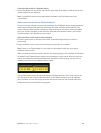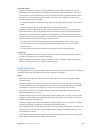Appendix B The Loopback plug-in 145
Loopback Sync, Snap To, and Play From parameters
The Sync, Snap To, and Play From pop-up menus in the bar at the bottom of the window control
various aspects of playback and synchronization of the audio material.
Sync, Snap To, and Play From parameters
•
Sync pop-up menu: Enables or disables synchronization with the MainStage tempo and clock.
•
Snap To pop-up menu: Determines how Loopback starts, in play or record mode, when stopped.
It also quantizes the tape loop length “on the y” by stopping the rst take.
•
O: Loopback starts immediately, without waiting.
•
Beat: Loopback starts or stops at the start of the next beat.
•
Bar: Loopback starts or stops at the start of the next bar.
•
Loop: Loopback waits for the amount of time dened by the Length parameter.
•
Play From pop-up menu: Determines the playback start position within the audio material.
•
Loop Start: Playback starts from the beginning of the audio material.
•
Relative Position: When you stop and restart the Loopback instance, playback continues as if
the plug-in had been playing continuously, without interruption. This is useful when several
Loopback instances are playing together, or when you are using Loopback instances with
Playback or Ultrabeat instances, allowing you to eectively “mute” and “unmute” instances
while keeping them in sync with each other.
Use the Loopback group functions
If you have multiple instances of the Loopback plug-in in a concert, you can use groups to
control which instances record and play together and which instances operate independently.
Any Loopback instance can either be assigned to one of 26 groups, named A-Z, or not be a
member of any group. The linked operation of multiple instances can be used for creative
purposes, such as alternative versions of a song verse or chorus.
Loopback and Playback instances share the same group functions. If you have instances of
Playback that you have assigned to a group, they will respond to any group functions (except
Record) as any Loopback instances assigned to the same group.
Only one group can be active at a time. For example, if two Loopback instances are in Group A,
and four Loopback instances are in Group B, activation of a transport function in any Group A
member will stop all Group B members, and vice versa. Instances that are not in any group
are not aected. Similarly, any Playback instance in Group A will also respond, while Playback
instances in Group B (or any other group) will stop.
All Loopback instances that belong to a group will switch between states for the following
transport functions when changed in any group member:
•
Record
•
Play or Stop
•
Return to Start
•
Dragging in the waveform display
•
Fade Out (time and action)
•
Count In
•
Metronome
•
Undo
•
Reverse


















